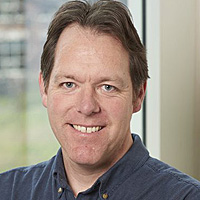
Northeastern Fellows Poised For ‘Most Ambitious’ Crack At Reinventing TV News


Mike Beaudet
For the better part of a decade, Mike Beaudet has been teaching young people the practice of investigative reporting for television at Northeastern University in Boston. He’s noticed a disturbing trend among his students.
“None of them sit down and watch a local TV newscast,” Beaudet says. “They want to go into the business; it’s just not how younger people get their news.”
If even the people who want to be on TV news don’t watch it, that certainly doesn’t bode well for the industry’s sustainability prospects. Not only does this bit of data indicate that local TV newscasts will likely have much smaller audiences in the future, but also that up-and-coming on-air talent won’t learn the trade from watching today’s pros.
In 2017, Northeastern launched the Reinventing Local TV News Project to help shape a future where TV news better attracts young viewers. Across two phases so far, the project has conducted a national survey, which helped identify a TV news programming need for more diverse and engaging content and found that when advanced animation and graphics are added to stories, audience interest and comprehension increases.
Beaudet, the project’s lead, says the third phase is the project’s most ambitious yet. It has begun with a call for applications to a year-long fellowship at one of three stations. Three content producers will write, shoot and edit content strictly for digital platforms — OTT channels, websites and social media feeds — associated with Hearst-owned WCVB Boston, CBS-owned WCBS New York and ABC-owned WLS Chicago. A fourth fellow at one of the stations will produce content steeped in animation and graphics.
The fellowship, dubbed The Streaming Video News Research Project, was made possible by a $1 million grant from the Stanton Foundation, which was founded by former CBS President Frank Stanton and his wife, in part to support the First Amendment and further inform citizens. Beaudet says that since the three station partners are not paying the fellows, it “frees up the expectations” of the work they’ll do, allowing them to “experiment with content, to cover stories that might not be getting covered and also produce them in creative ways that might be looking a little different than traditional TV news.”
In other words, “The ultimate goal is to get them in there for a year and just let them loose,” Beaudet says, and over the course of the project develop what he calls a “playbook” for local stations on how to best develop content for digital platforms. He says doing so will “give the industry some pathways [to] meet younger audiences where they’re consuming news and get them interested in the content that TV stations produce.”
The production work by the four fellows across their year-long placement is just one element of the project’s third phase. The grant runs a total of three years, and after the fellows develop the digital content, project leaders will analyze what worked well and what didn’t — data that will inform the playbook on how to do digital right.
Another measure of success for the project, Beaudet says, is “how many other stations ultimately hire OTT streaming content producers.” Project leaders will work to get such talent recruited at stations across the country in an effort to “replicate,” as Beaudet puts it, the fellowship elsewhere. A conference in Boston is planned for next year in which industry stakeholders will gather to discuss digital production strategies developed during the fellowship.
Beaudet says feedback from station managers and the project’s researchers about the fellows’ work will help generate the resulting playbook. Viewership data and audience research, possibly conducted through surveys and/or focus groups, will also inform the project’s ultimate report.
Social media response will also be measured, with Instagram and Tik-Tok sure to be a focus. Newsrooms, for the most part, have not effectively posted content on those platforms as of yet, Beaudet says, because “it’s older people trying to figure out a medium that they’re not completely comfortable in.” The Northeastern fellows will “bring that younger sensibility” to that particular newsroom effort, he observes.
Project leaders are looking for individuals with some (but not a lot of) experience in newsrooms to fill the three OTT streaming content producer positions, in large part because the stations in which they will work are in large markets with sizable viewerships. “We want people who are storytellers, both video and digital, and can bring a creativity and youthful energy that you might not see” in some newsrooms, Beaudet says.
In the case of the animation- and graphics-focused producer, the ideal applicant will, according to the application page, have a “background in graphic design, animation, or a related field, at least three years of experience in motion graphics and video production, and be proficient in Adobe After Effects and Premiere Pro.” The project wants the prospective animator to “have a keen eye for design and data visualization,” and be able to “conceptualize and execute visually stunning content that enhances news stories.” Beaudet says they’d actually prefer someone who doesn’t have a traditional journalism background, so that they might offer fresh eyes with a better chance at developing content that’s innovative in the TV news space.
One area Beaudet sees as viable for more investment is longer-form content in digital, where linear constraints don’t apply. Beaudet believes longer content can still capture audiences’ attention, given that it is well-produced and meaningful to people.
“There’s a value to breaking news because it’s informing the community,” he says, “but at the end of the day, producing longer format content that focuses on issues that are actually relevant to people in their communities, I think that’s going to resonate.”
The fellows will be placed at their stations as soon as September, Beaudet says. In general, he understands that many stations may not have the resources to hire a brand-new digital content producer. But he hopes the project, the work of the fellows and the resulting playbook inspires managers to, at the very least, take at least one of their general assignment reporters focused on TV story production and reposition them at a desk for digital. “Success will be when we see OTT streaming content producers hired across the country,” Beaudet says.
“We are proud to partner with the Northeastern School of Journalism and the Stanton Foundation to experiment with local content that is developed specifically for our growing streaming audience,” said Sarah Burke, WCBS VP-news director, in a press release about the fellowship. “Engaging the next generation on OTT with content that resonates with them is vital to the health of our communities and our democracy.”
According to Beaudet, the three stations were identified as ideal partners through conversations with advisers as well as direct connections he had with them.
Beaudet himself has worked in TV news for more than 30 years and maintains a position as a multimedia investigative journalist at WCVB. He says the project aims to show TV news companies that they must invest in digital channels much more than they already are.
“We’re not giving digital enough attention,” he says. “We need to do a better job and focus more of the resources [in that direction]. If you look at audience trends in terms of viewers, yes, local TV is still profitable, but the viewership is declining and continues to erode, and so if we don’t build up on the digital space and really figure out how to deliver news and information in that space, I think we’re missing a huge opportunity.”
The industry has been relatively slow in its pivot toward digital given the lion’s share of revenue still comes from linear TV, Beaudet says. That fact continues to hamper digital investment, which he says is shortsighted of the industry.
“We need to invest in this now because that is what’s going to pay the bills later.”
























Comments (4)
Hank Price says:
July 25, 2023 at 9:16 am
“Let them loose.” What a great idea. Rather than stuffing these students into the straitjacket of conventional thinking, the will be allowed to use the media and communication tools they know best.
Former Producer says:
July 25, 2023 at 3:25 pm
This really gets at the core of why the TV news business is in trouble. Digital and streaming are the future of journalism! But broadcasters simply won’t invest the money in this. They’d rather continue to siphon whatever revenue they can from traditional linear TV.
Guess what? That’s a recipe for failure. Advertising revenue is at risk because advertisers are moving to digital and streaming. Retransmission revenue is also at risk because cable and satellite operators are less willing to fork over more money to broadcasters who can’t deliver audience sizes like before.
Meanwhile, the next generation of news consumers are getting their news and information from digital and streaming sources. Who needs to watch the 6 pm news when you can get your news on your phone? Broadcasters would do well to actually invest in digital and streaming news and not cling to the past.
I applaud Northeastern and Beaudet. What they’re doing is the future of journalism and I sincerely hope more people jump aboard. Broadcasters — specifically, Perry Sook, Chris Ripley, Hilton Howell, Adam Samson, and Dave Lougee — need to either bite the bullet and make the investment in that future, or, face the same fate as the newspaper industry.
Former Producer says:
July 25, 2023 at 3:25 pm
**Symson, not Samson. Oops!
Kathy Haley says:
July 25, 2023 at 4:21 pm
Agreed, Hank! Let the fellowship winners communicate what they want the way they want and see if they move the needle. This is harder than it looks, but digital is a great place to experiment without taxing the linear newscasts.